A4200 road
| A4200 | ||||
|---|---|---|---|---|
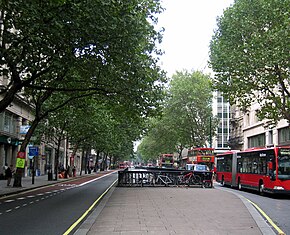 A4200 Kingsway from the south in 2009 | ||||
| Route information | ||||
| Length | 2.0 mi (3.2 km) | |||
| Major junctions | ||||
| South end | A4Aldwych | |||
| East end | A400Camden High Street, next toMornington Crescent tube station | |||
| Location | ||||
| Country | United Kingdom | |||
| Constituent country | England | |||
| Administrative areas | Greater London | |||
| Primary destinations | Aldwych Holborn Bloomsbury Euston Somerstown Camden Town | |||
| Road network | ||||
| ||||
TheA4200is a major thoroughfare incentral London.It runs between theA4atAldwych,to theA400Hampstead Road/Camden High Street,atMornington Crescent tube station,viaHolborn,Bloomsbury,EustonandSomerstown.
Kingsway[edit]




Kingswayis a major road incentral London,designated as part of theA4200.It runs fromHigh Holborn,at its north end in theLondon Borough of Camden,and meetsAldwychin the south in theCity of WestminsteratBush House.It was opened by King Edward VII in 1905.[1]Together Kingsway and Aldwych form one of the major north–south routes through central London linking the ancient east–west routes ofHigh HolbornandStrand.The name "King's Way" originally applied to what is nowTheobalds Road,as it was the route thatKing James Itook when travelling from London to his residenceTheobalds Palacein Hertfordshire.
History[edit]
Building the road[edit]
The road was purpose-built as part of a major redevelopment of the area in the 1900s. Its route cleared away the maze of small streets in Holborn such as Little Queen Street and the surrounding slum dwellings. However Holy Trinity Church, which was built in Little Queen Street was spared, whereas theSardinian Embassy Chapel,an importantRoman Catholicchurch attached to the Embassy of theKingdom of Sardinia,was demolished to make way for the new street.
Plans were published byLondon County Councilin 1898, authorised by theLondon County Council (Improvements) Act 1899(62 & 63 Vict.c. cclxvi) and the road was formally opened in 1905. It is one of the broadest streets in central London at 100 feet (30 m) wide. There were several proposed names for the new street, includingKing Edward VII Street,Empire Avenue,Imperial AvenueandConnecticut Avenue.The name "Kingsway" was in honour of KingEdward VII,who opened the street.[2]
Tramway tunnel[edit]
It was unique in containing below it a tunnel for atramway,which started just north of Southampton Row, passed beneath Aldwych and continued to the Thames Embankment: thisKingsway tramway subwayjoined the North and South London tram systems. In 1958 the disused tunnel was reopened at the southern end to make a new connection, the Strand Underpass, for light traffic between Waterloo Bridge and Kingsway in order to reduce congestion. Also beneath Kingsway was a branch of thePiccadilly tube linefrom Holborn toAldwych stationon the Strand. It was closed in 1994. Aldwych station is still used for television and film sets that require underground scenes. During theSecond World Warthe branch was used to store art treasures from theBritish Museum,including theElgin Marbles.[3]
2015 underground electrical cable fire[edit]
On 1 April 2015, electrical cables under the pavement in Kingsway caught fire, leading to serious disruption in central London. The fire continued for the next two days, with flames shooting out of a manhole cover from a burst gas main,[4]before being extinguished.[5]Several thousand people were evacuated from nearby offices, and several theatres cancelled performances.[6][4][7]There was also substantial disruption to telecoms infrastructure.[8]On 8 April, press reports emerged stating that the fire may have been started as part of the2015 Hatton Garden burglary;[9]however on 9 April, the investigation into how the fire started stated that it came from an electrical fault.[10]
Buildings[edit]
The original buildings were built between 1903 and 1905. They were mostly mid-rises in stone, and in various styles including neoclassical and neo-Baroque. Many survive but some have been replaced. Notable buildings include:
- 61 Aldwych, previouslyTelevision House,the headquarters ofAssociated-RediffusionTelevision[11]
- Africa House[12]
- Alexandra House
- Aviation House,formerly the Church of the Holy Trinity, in an Edwardian Baroque style.[13]
- Bush House,King's College London[14][15]
- Civil Aviation Authority House(formerly known as Space House)[16]
- Kingsway Hall,Methodist mission hall opened in 1912 and from 1926, the church allowed HMV, EMI from 1931, to use it as a recording studio. In 1944 EMI were joined byDecca Records
- Victory House (the London CentralEmployment Tribunal)[17]
- York House[18]
- Various buildings of theLondon School of Economics
Transport[edit]
Closest London Underground stations[edit]
The closest tube stations areHolborn,which is at the top of the road, at the junction with High Holborn, as well asTemple,and formerlyAldwych,which closed in 1994.

Strand Underpass[edit]
As part of the redevelopment atram tunnelwas built underneath the road.[19][20][21]The trams ceased to run in the 1950s and, since 1961, the southern end of the tunnel has been used by cars under the name of theStrand Underpass.[22][23]The northern entrance to the tunnel still exists[24](with its tram lines stillin situ,see image right)[25]and can be found at the junction of Southampton Row and Vernon Place.
Culture[edit]
1909 Edward Elgar song[edit]
On 27 December 1909, a song by the English composerEdward Elgar,namedThe King's Way,celebrates the opening of Kingsway. The words are written by his wife,Caroline Alice Elgar.The song was first performed at anAlexandra Palaceconcert on 15 January 1910, sung byClara Butt.[26] [27][28]
Southampton Row[edit]
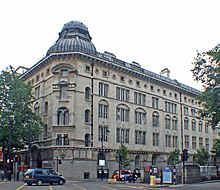
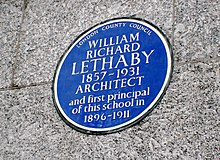

Southampton Row is a major thoroughfare running northwest–southeast inBloomsbury,Camden,central London,England.
Name[edit]
The street was named afterThomas Wriothesley, 4th Earl of Southampton.[29]It was previously known asKing Street
History[edit]
1822 – Henry Hetherington printing press[edit]
In 1822, theChartistHenry Hetheringtonregistered a printing press at 13 Kingsgate Street (a smaller street parallel to King street, but demolished during the 1903-05 Kingsway development). This was an eight-roomed house, including shop and printing premises—at an annual rent of £55.[30]His first published book was in January 1823, and was named Mudie's journal, thePolitical Economist and Universal Philanthropist.[31]
Pre–1837 – home of Robert William Sievier[edit]
The first studio of the sculptorRobert William Sievier(1794–1865) was in Southampton Row until 1837, where he relocated to Henrietta Street, nearCavendish Square,and he also had a separate residence inUpper Holloway.[32]
1896 – beginning of the Central School of Art & Design[edit]
TheCentral School of Art and Design,formerly theCentral School of Arts and Crafts,was established by theLondon County Councilin 1896 in Southampton Row[33][34]to provide specialist art teaching for workers in the craft industries. The architectWilliam Lethaby(1857–1931)[35]was the firstPrincipal,as recorded by ablue plaqueon Southampton Row.[36]
1899 – Sir John Barbirolli was born[edit]
Sir John Barbirolli,the conductor and cellist, was born in Southampton Row on 2 December 1899. A commemorative blue plaque was placed on the wall of the Bloomsbury Park Hotel in May 1993 to mark his birthplace.[37]
1907 – Institute of Education moving buildings[edit]
In 1907, theInstitute of Educationmoved to its first purpose-built building on Southampton Row.[38]In 1938, the Institute moved to theSenate House complexof theUniversity of LondononMalet Street,not far away to the northwest.[39] [40]
1933 – Leó Szilárd insight[edit]
On 12 September 1933, the Hungarian physicistLeó Szilárd,an exile from Nazi Germany, was crossing Southampton Row at the junction with Russell Square when he conceived the idea of anuclear chain reaction,which led directly to the development ofnuclear weaponsandnuclear power.[41]
1953 – beginning of the Sue Ryder Care charity[edit]
TheSue Ryder Carecharity, established in 1953, is registered at 114–118 Southampton Row.
1953 - bookshop opening[edit]
Also in 1953, John Cass opened a bookshop on Southampton Row, where he began publishing books and journals which were acquired byTaylor & Francisin 2003.[42]
1966 – Indica Bookshop and Indica Galley separation[edit]
In 1966, theIndica Bookshopwas separated from theIndica Gallery,a counterculture art gallery supported byPaul McCartney,and moved to 102 Southampton Row in the summer of that year.
Today[edit]
As of 2022[update]a major route for buses, the street once formed part of atramroute that includeda tunnel for trams.
Woburn Place and Upper Woburn Place[edit]
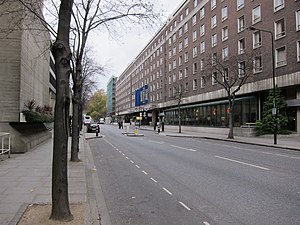
Woburn Placeis a street in centralLondon,England, named afterWoburn Abbey,home to the Dukes of Bedford who developed much of Bloomsbury. It is located in theBloomsburyarea ofCamden.[43][44]
Surroundings[edit]
To the north isTavistock Squareand to the south-east isRussell Square.Past Tavistock Square the road becomesUpper Woburn Placeuntil the junction withEuston Road.TheRoyal National Hotelbuilding is located in the south-west side of Woburn Place north of Russell Square, with 1,630 rooms on eight floors, is the largest hotel in the UK.[45]TheBritish Medical Associationbuilding[46]is at the junction of Upper Woburn Place with Tavistock Square.
Property values[edit]
Property values are high in this area. For example, in 2005 a freehold office building at 19–29 Woburn Place (9,400 m2,101,000 sq ft) was sold for £22.6 million.[47]
7 July 2005 bombing[edit]
On 7 July 2005, asuicide bombplanted by 18-year-oldHasib Hussaindetonated aboard adouble decker buspassing Tavistock Square as it was travelling fromMarble Archto Oxford Circus onroute 30,killing 13 passengers, plus Hussain himself. The bus had been diverted to Woburn Place due to road closures resulting from the earlier bombings.[48]
Eversholt Street[edit]
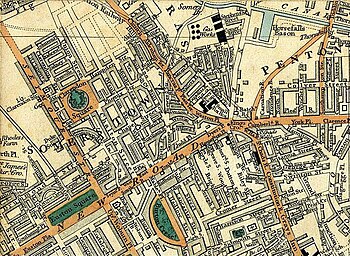
Eversholt Street is a street in theLondon Borough of CamdeninLondon,England.It lies inSomers Town, London:stretching a kilometre fromEuston railway stationin the south toCamden Townin the north.
Route[edit]
Eversholt Street starts atEuston Road,betweenEuston Square GardensandEuston Fire Station.[49]It travels north, includingEuston House,the grade-II listedRoyal George,[50]the grade-II listed64 Eversholt Street,[51]the grade-II listedChurch of St Mary the Virgin,[52]the grade-II listedEversholt House,[53]and Camden Council's The Crowndale Centre which includesCamden Town Library.It joins Camden High Street atMornington Crescent station.It also includes a controversial strip bar that is the subject of many articles in local newspapers.[54][55][56][57]
History[edit]
The road was laid out in the 1810s as part of theBedford Estate.[58]It was called "Seymour Street", as shown in the map to the right, until 1938 when it was renamed.[59]It took its new name fromEversholtwhich is a village in Bedfordshire (which comes fromAnglo-Saxonmeaning "wood of the wild boar" ) nearAmpthill,which gave its name toAmpthill Squarenearby, and follows a theme of names related to theDuke of Bedford.It in turn gives its name toEversholt Rail Group.
See also[edit]
- Kingsway telephone exchange,an underground telephone exchange in Chancery Lane.[60]
- List of eponymous roads in London
- Southampton Street,Westminster, London
- Sicilian Avenue,Bloomsbury,London
- Woburn Square
- Woburn Walk
References[edit]
- ^"Kingsway and Aldwych".Royal Institute of British Architects(RIBA).Archived fromthe originalon 24 December 2016.
- ^Ben Weinreb;Christopher Hibbert(1992).The London Encyclopaedia(reprint ed.).Macmillan.pp. 450–451.
- ^John Glover (1999).London's Underground.Hersham, England: Ian Allan.ISBN0-7110-2636-X.
- ^abAnna O'Neill (1 April 2015)."Holborn electrical fire causes mass evacuation".BBC News.Retrieved2 April2015.
- ^"Holborn underground fire extinguished".BBC News. 3 April 2015.Retrieved4 April2015.
- ^Ross Lydall; Matt Watts; Anna Dubuis; Lizzie Edmonds (2 April 2015)."Holborn fire costs London firms £40m: Full scale of damage and disruption revealed".Evening Standard.Retrieved2 April2015.
- ^Roisin O'Connor (2 April 2015)."Holborn fire: Kingsway remains closed as firefighters continue to tackle blaze burning under pavement in central London".The Independent.Retrieved2 April2015.
- ^Alex Scroxton (2 April 2015)."Kingsway fire brings down broadband services in London".Computer Weekly.Retrieved4 April2015.
- ^Rachel Blundy; Sebastian Mann (8 April 2015)."Holborn fire 'could have been deliberately started by burglars responsible for Hatton Garden jewel heist'".Evening Standard.
- ^"Holborn underground fire: Electrical fault caused 36-hour blaze".BBC News. 9 April 2015.Retrieved10 October2022.
- ^"61 Aldwych".Retrieved6 October2022.
- ^"Africa House London".Retrieved6 October2022.
- ^Historic England."Church of the Holy Trinity (1379262)".National Heritage List for England.Retrieved10 January2016.
- ^"Bush House".King's College London.Retrieved7 October2022.
- ^"Bush House".BBC 100.Retrieved7 October2022.
- ^Historic England."Space House (now Civil Aviation Authority House) (1421847)".National Heritage List for England.Retrieved10 January2016.
- ^"Central London Employment Tribunal".Evening Standard.Retrieved7 October2022.
- ^York House,inSurvey of London:Volume 18, St Martin-in-The-Fields II: the Strand, ed. G H Gater and E P Wheeler (London, 1937), pp. 51-60 (accessed 16 May 2015)
- ^"Kingsway Subway Tunnel".Stories of London.Retrieved8 October2022.
- ^"Kingsway tram subway tunnels".Engineering Timeline.Retrieved8 October2022.
- ^Nick Catford (1 August 1994)."Kingsway Tram Subway".Subterranea Britannica.Retrieved8 October2022.
- ^"Building Strand Underpass (1963)".YouTube.13 April 2014.Retrieved7 October2022– via British Pathé.
- ^"Construction of the Strand Underpass, 1963".London Metropolitan Archives.Retrieved8 October2022.
- ^Gareth Prior (30 December 2020)."Still Standing! Kingsway Tram Tunnel, London".British Trams Online.Retrieved8 October2022.
- ^Ian Mansfield (5 July 2012)."Photos from inside the abandoned Kingsway Tram Tunnels".IanVisits.Retrieved8 October2022.
- ^Kennedy, Michael,Portrait of Elgar(Oxford University Press, Third ed., 1987)ISBN0-19-284017-7
- ^Moore, Jerrold N.Edward Elgar: A Creative Life(Oxford University Press, 1984)ISBN0-19-315447-1
- ^The King's Way:Scores at theInternational Music Score Library Project
- ^"History of The Bloomsbury Estate".The Bedford Estates.Retrieved8 October2022.
- ^Hollis, 'Introduction',The Poor Man's Guardian1831-1835, p. vii.
- ^Brake, L., and Demoor, M., (Eds.) Dictionary of Nineteenth-century Journalism in Great Britain and Ireland (Academia Press and The British Library, 2009;ISBN978-0-7123-5039-6) p. 281.
- ^Sievier, Robert William (1794-1865)
- ^"Central School of Arts and Crafts".Oxford Reference.Retrieved8 October2022.
- ^"CENTRAL ST MARTIN'S COLLEGE OF ART AND DESIGN (1378790)".Historic England.Retrieved8 October2022.
- ^"William Lethaby".Internet Archive.Retrieved8 October2022.
- ^"LETHABY, WILLIAM RICHARD (1857-1931)".English Heritage.Retrieved8 October2022.
- ^"Conductor Laureate Hallé Orchestra Sir John Barbirolli C.H. 1899–1970 was born here".Open Plaques.Retrieved8 October2022.
- ^Aldrich (2002).The Institute of Education 1902–2002.p. 35.
- ^Aldrich (2002).The Institute of Education 1902–2002.p. 110.
- ^Aldrich/Woodin (2021).The Institute of Education, 2e.London: UCL Press.ISBN978-1-78735-951-2.
- ^Bronowski, Jacob(1973).The Ascent of Man.BBC Books. p. 369.ISBN1849901155.
- ^Holmes, Colin(2009)."Frank Cass (1930–2007)".Immigrants and Minorities.27(1): 118–122.doi:10.1080/02619280902895686.
- ^"Shops on Woburn Place, WC1H".London Online information.Retrieved21 September2022.
- ^"Woburn Place".London Town.Retrieved21 September2022.
- ^Girling, Brian (28 February 2014).Bloomsbury & Fitzrovia Through Time.Amberley Publishing Limited.ISBN9781445627038.
- ^Historic England."British Medical Association House including Screen and Gates (1378968)".National Heritage List for England.Retrieved6 June2020.
- ^"Derwent Valley".27 April 2005. Archived fromthe originalon 12 October 2006.Retrieved28 February2007.
- ^"7 July London bombings: What happened that day?".BBC News. 3 July 2015.Retrieved6 October2022.
- ^"Euston Fire Station".Historic England.14 May 1974.Retrieved19 September2022.
- ^"The Royal George, 8-14 Eversholt Street".Historic England.11 January 1999.Retrieved19 September2022.
- ^"64 Eversholt Street".Historic England.14 May 1974.Retrieved19 September2022.
- ^"Church of St Mary the Virgin".Historic England.10 June 1954.Retrieved19 September2022.
- ^"Eversholt House, 163-203 Eversholt Street".Historic England.14 May 1974.Retrieved19 September2022.
- ^Isabelle Stanley (3 December 2021)."New delays to lap-dancing club licensing reforms".Camden New Journal.Retrieved19 September2022.
- ^Richard Osley (20 February 2020)."The case of the £50k lap-dancing bill: 'It's not exceptional', says boss".Camden New Journal.Retrieved19 September2022.
- ^Richard Osley (30 January 2020)."Lap-dancers call for club facing rip-off claims to keep licence".Camden New Journal.Retrieved19 September2022.
- ^Richard Osley (4 November 2019)."Last dance? Councillors back tougher regime for strip clubs".Camden New Journal.Retrieved19 September2022.
- ^"Eversholt Street, NW1".The Underground Map.13 July 2021.Retrieved19 September2022.
- ^Cooke, B.W.C., ed. (December 1954). "The Railway Clearing House".The Railway Magazine.Vol. 100, no. 644. Westminster: Tothill Press. p. 812.
- ^Nick Catford & Andy Emmerson (25 February 2008)."Kingsway Telephone Exchange".Subterranea Britannica.Retrieved6 October2022.

